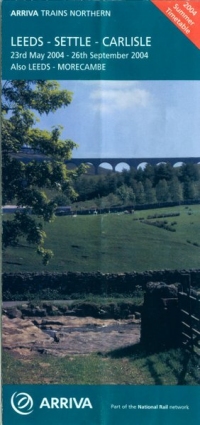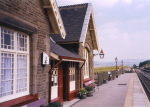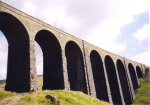Settle-Carlisle Railway
| Settle-Carlisle Railway |
| Principal stations (Airedale Line) |
The Settle–Carlisle Railway (S&C) is a 72 mile (115 km) long main railway line in northern England. It is also known as the Settle to Carlisle and Settle and Carlisle, or by a fuller title the Leeds–Skipton–Settle–Carlisle Railway. It is a part of the National Rail network and was constructed in the 1870s. Apart from temporary diversions (such as due to the closure of the West Coast Main Line) all passenger trains are operated by Northern Rail.
The line runs through remote regions of the Yorkshire Dales and the North Pennines, and is considered to be one of the most scenic railways in England.
Due to a combination of the hilly terrain through which it passes, and the fact that it was constructed to main-line standard rather than as a local railway, the S&C was a major trial of engineering. It contains 14 tunnels and 22 viaducts, the most notable being the Ribblehead Viaduct.
The line runs from near the town of Settle, beginning at a junction with the line from Leeds to Morecambe, extending to the city of Carlisle on the England/Scotland border. On the way the line passes through the town of Appleby and a number of small communities.
History
The S&C was built by the Midland Railway company, after a dispute with the London and North Western Railway over access to Scotland over the LNWR's route.
Construction work started in 1870, and was completed in 1876. It was engineered to express standards throughout.
After nearly a century of uneventful existence in the 1960s, as a part of the Beeching Axe the S&C had many of its minor stations closed in 1970 and its stopping passenger service cut to just two a day, leaving only freight and a handful of passenger services operating on the line. Of the expresses, The Waverley from London to Edinburgh via Nottingham ended in 1964, while the Thames-Clyde Express from London to Glasgow via Leicester, lasted until 1974.
From the 1960s until the 1980s the S&C suffered a drought of investment, and much freight traffic was diverted onto the West Coast Main Line. Because of the lack of investment the condition of many of the viaducts and tunnels on the line was deteriorating.
Threat of closure

In the early 1980s, the S&C was carrying only a handful of trains per day, and British Rail decided that the cost of renewing the viaducts and tunnels would be prohibitively expensive, given the small amount of traffic carried on the line. In 1981 the Friends of the Settle-Carlisle Line ([1]) were established, who campaigned against the line's closure even before it was officially announced.
In 1984 closure notices were posted at the S&C's remaining stations. However, local authorities and rail enthusiasts joined together and started a campaign to save the S&C, pointing out that British Rail was ignoring the S&C's potential for tourism. The campaign uncovered convincing evidence that British Railways had mounted a dirty tricks campaign against the line, exaggerating the cost of repairs and deliberately diverting traffic from the line in order to justify its closure plans (a process referred to as closure by stealth). British Rail eventually agreed to keep the line open in 1989, and to repair the deteriorating tunnels and viaducts ([2]).
The story of the closure threat and the subsequent saving of the line is told in Stan Abbott and Alan Whitehouse's book (see the Further Reading section).
The line today
In recent years, due to congestion on the West Coast Main Line, much freight traffic is using the S&C once again, and local passenger traffic has increased, with many of the minor stations re-opened. The line continues to be an important diversionary route from the West Coast Main Line during engineering works.
The S&C is probably busier now (2006) than at any time in its history. Major engineering work is required to bring the line up to the standards required for heavy freight and passenger use - check www.settle-carlisle.co.uk for the latest news.
The route of the line is described more fully in the Airedale Line article or on the official Settle-Carlisle line website - www.settle-carlisle.co.uk.
External links
- Settle - Carlisle Partnership - timetables, online secure shop, route guides and the latest news
- - History and Photo Tour of the Settle and Carlisle Railway
Further reading
- Abbott, Stan and Whitehouse, Alan (1994) The line that refused to die. Hawes: Leading Edge. (Revised edition, first published 1990) ISBN 0-948135-43-3


